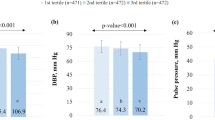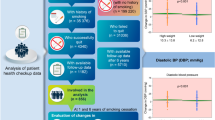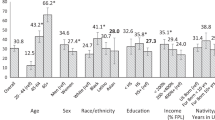Abstract
Overweight and obese hypertensive patients can greatly benefit from high adherence rates for lifestyle modifications. The objectives of this paper were to investigate how patients' weight status affected physicians' recommendations of lifestyle modifications and patients' adherence after they received the recommendations. The patients were adults (18+ years of age) with hypertension (prehypertension, Stage I and Stage II hypertension). The National Health and Nutrition Examination Survey (NHANES) 1999–2000 was used. Weight status was categorized as normal/underweight, overweight and obese. Physicians' recommendations of and patients' adherence to lifestyle modifications (weight control, exercise, sodium intake reduction, alcohol intake reduction) were examined using descriptive and multivariate analyses, controlling for weight status, hypertension stage, comorbidities and demographic characteristics. About 57.0% of the US adult population in 1999–2000 had prehypertension, Stages I or II hypertension. Among the hypertensive adults, 30.3% were normal/underweight, 32.6% were overweight and 37.2% were obese. We found that physicians were more aggressive in recommending lifestyle modification for obese patients. In contrast, obese hypertensive patients were not found to be more likely than normal/underweight patients to adhere to lifestyle modification recommendations. In addition, adherence rates for sodium and alcohol consumption reduction were higher than that for either exercise or weight control. In conclusion, more aggressive approaches should be taken by physicians to educate obese patients about the benefits of lifestyle modifications and to improve adherence to enhance the effects of antihypertensive medications.
This is a preview of subscription content, access via your institution
Access options
Subscribe to this journal
Receive 12 digital issues and online access to articles
$119.00 per year
only $9.92 per issue
Buy this article
- Purchase on Springer Link
- Instant access to full article PDF
Prices may be subject to local taxes which are calculated during checkout
Similar content being viewed by others
References
Joint National Committee. The sixth report of the Joint National Committee on prevention, detection, evaluation, and treatment of high blood pressure. Arch Intern Med 1997; 157: 2413–2446.
Chobanian AV et al. The Seventh Report of the Joint National Committee on prevention, detection, evaluation, and treatment of high blood pressure: the JNC 7 report. JAMA 2003; 289: 2560–2572.
Costa FV . Non-pharmacological treatment of hypertension in women. J Hypertens 2002; 20 (Suppl 2): S57–S61.
Egede LE . Lifestyle modification to improve blood pressure control in individuals with diabetes: is physician advice effective? Diabetes Care 2003; 26: 602–607.
Schoberberger R, Janda M, Pescosta W, Sonneck G . The COMpliance Praxis Survey (COMPASS): a multidimensional instrument to monitor compliance for patients on antihypertensive medication. J Hum Hypertens 2002; 16: 779–787.
Burt VL et al. Prevalence of hypertension in the US adult population. Results from the Third National Health and Nutrition Examination Survey, 1988–1991. Hypertension 1995; 25: 305–313.
Karppanen H, Mervaala E . Adherence to and population impact of non-pharmacological and pharmacological antihypertensive therapy. J Hum Hypertens 1996; 10 (Suppl 1): S57–S61.
Egede LE, Ye X, Zheng D, Silverstein MD . The prevalence and pattern of complementary and alternative medicine use in individuals with diabetes. Diabetes Care 2002; 25: 324–329.
Pronk NP et al. Meeting recommendations for multiple healthy lifestyle factors. Prevalence, clustering, and predictors among adolescent, adult, and senior health plan members. Am J Prev Med 2004; 27 (2 Suppl): 25–33.
Women's Health Initiative Study Group. Dietary adherence in the women's health initiative dietary modification trial. J Am Diet Assoc 2004; 104: 654–658.
Hebl MR, Xu J, Mason MF . Weighing the care: patients' perceptions of physician care as a function of gender and weight. Int J Obes Relat Metab Disord 2003; 27: 269–275.
Drury CA, Louis M . Exploring the association between body weight, stigma of obesity, and health care avoidance. J Am Acad Nurse Pract 2002; 14: 554–561.
Rosen AB, Schneider EC . Colorectal cancer screening disparities related to obesity and gender. J Gen Intern Med 2004; 19: 332–338.
Weir MR et al. Implications of a health lifestyle and medication analysis for improving hypertension control. Arch Intern Med 2000; 160: 481–490.
National Center for Health Statistics. National Health and Nutrition Examination Survey. CDC. Available at: http://www.cdc.gov/nchs/nhanes.htm,accessed 15 June 2004.
Lohman TG . Anthropometric Standardization Reference Manual. Human Kinetics Books: Champaign, IL, 1988.
CDC. Available at: http://www.cdc.gov/nccdphp/dnpa/obesity/, accessed 10 June 2004.
Apter AJ et al. Modifiable barriers to adherence to inhaled steroids among adults with asthma: it's not just black and white. J Allergy Clin Immunol 2003; 111: 1219–1226.
Berrigan D et al. Patterns of health behavior in US adults. Prev Med 2003; 36: 615–623.
Kleeberger CA et al. Determinants of heterogeneous adherence to HIV-antiretroviral therapies in the Multicenter AIDS Cohort Study. J Acquir Immune Defic Syndr 2001; 26: 82–92.
Jorgensen WA, Polivka BJ, Lennie TA . Perceived adherence to prescribed or recommended standards of care among adults with diabetes. Diabetes Educ 2002; 28: 989–998.
Polley BA et al. The effects of health beliefs on weight loss in individuals at high risk for NIDDM. Diabetes Care 1997; 20: 1533–1538.
Jakicic JM, Wing RR, Butler BA, Robertson RJ . Prescribing exercise in multiple short bouts versus one continuous bout: effects on adherence, cardiorespiratory fitness, and weight loss in overweight women. Int J Obes Relat Metab Disord 1995; 19: 893–901.
Hajjar I, Kotchen TA . Trends in prevalence, awareness, treatment, and control of hypertension in the United States, 1988–2000. JAMA 2003; 290: 199–206.
Author information
Authors and Affiliations
Corresponding author
Rights and permissions
About this article
Cite this article
Xu, K., Ragain, R. Effects of weight status on the recommendations of and adherence to lifestyle modifications among hypertensive adults. J Hum Hypertens 19, 365–371 (2005). https://doi.org/10.1038/sj.jhh.1001828
Received:
Revised:
Accepted:
Published:
Issue Date:
DOI: https://doi.org/10.1038/sj.jhh.1001828
Keywords
This article is cited by
-
Prehypertension: is it relevant for nephrologists?
Kidney International (2010)
-
Adherence to healthy lifestyle in hypertensive patients: ample room for improvement?
Journal of Human Hypertension (2010)
-
Accumulation of 30 min of moderately intense physical activity is a clinically meaningful treatment to reduce systolic blood pressure in prehypertension
Journal of Human Hypertension (2008)
-
Racial/ethnic variation in hypertension-related lifestyle behaviours among US women with self-reported hypertension
Journal of Human Hypertension (2008)
-
Promotion of behavioural change in people with hypertension: an intervention study
Pharmacy World & Science (2008)



